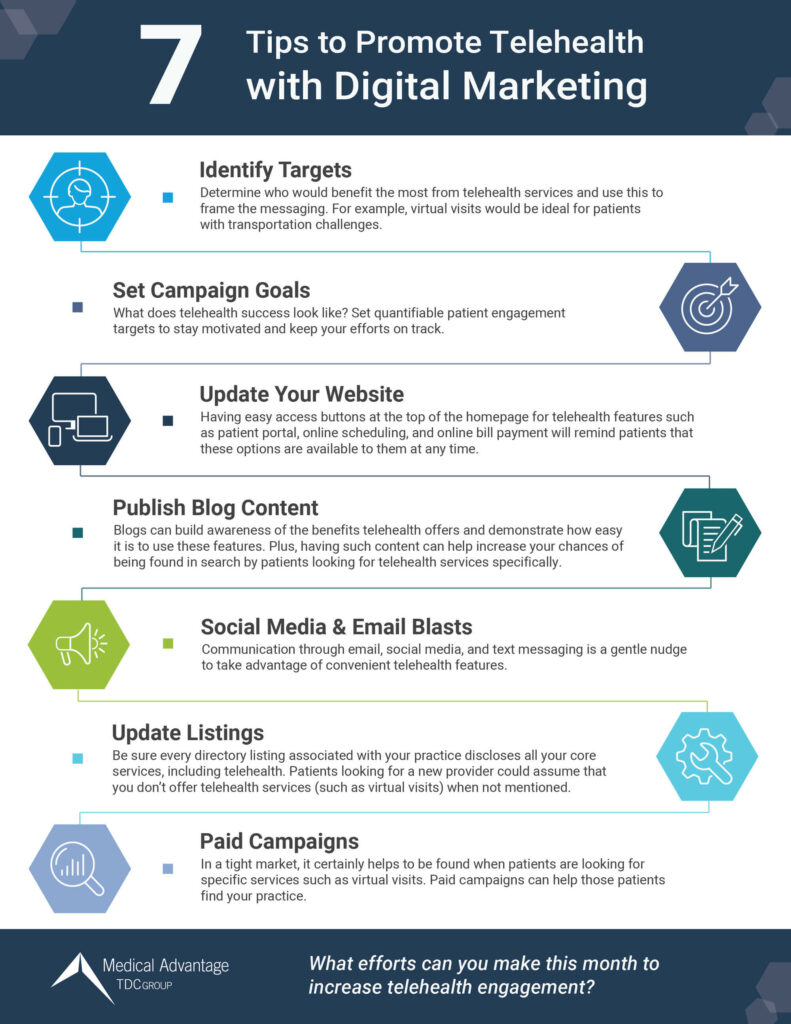For providers around the world, telehealth meant that care for many patients could continue during the 2020 pandemic lockdowns. Through this experience, we learned what we are able to accomplish despite isolation. While virtual visits are a common aspect of telehealth delivery, other forms of remote care are digital text communication, electronic transfer of medical records, RPM (remote patient monitoring).
Getting patients to engage with the telehealth services you provide begins by making them aware of this option. Telehealth marketing is an effective way to attract patients who seek the easiest and most convenient (and in the context of COVID, the safest) way to access healthcare.
Patient participation can be activated when patients are presented with the power of choice. Having a telehealth marketing plan helps practices achieve engagement goals by actively encouraging patients to access services through technology. Promotion through healthcare marketing is one such effort to achieve this target.
Promoting Your Telehealth Offering
Converting a practice from in-person to mainly virtual draws upon many resources, including staff training, new equipment, new software, and more. After investing so much time, effort, and money to get a telehealth process running smoothly, one would naturally want to get the most out of this investment.
Patients have acclimated to a more convenient way of accessing healthcare that allows them to visit with the provider remotely as well as other telehealth tasks. However, patients may continue to assume that a given practice is still providing care the traditional way.
Patients with socioeconomic challenges may end up disenfranchised from care because they lack the means to come in for an appointment.
All of the above scenarios are reasons to promote your telehealth options. A practice equipped for telehealth can continue to reap benefits beyond the pandemic, but only when patients continue to engage with it.
Benefits of Telehealth
Why put so much effort into a healthcare service that seems to live in the periphery? There are several reasons why telehealth promotion is worth the effort.
- Grow your patient population – Positioning your practice as one that removes barriers to care with the convenience of technology attracts patients near and very far out.
- Flexibility – In-person or virtual, patients have their pick of which works best for them.
- Hassle-free follow-ups – Patients may begin to wonder why they have to come in person for something that ends up being a simple conversation. Virtual visits allow you to check in with the patient in a way that does not take up too much of their time.
- More efficient collaboration with other providers – Digital front door integration allows providers to share critical information as they work together to care for one patient.
- Increased engagement leading to better adherence – When more convenient care encourages better engagement, patients are more likely to adhere to care plans which leads to better outcomes
- Cost reductions – Freeing up resources spent during the in-person visit, reduced paperwork, more exam rooms freed up to see more in-person patients, reduced travel costs and time off work or school are all examples of how telehealth cuts costs on both sides of the equation.
Telehealth: A Growing Market Sector
Most care went the way of telemedicine in 2020, but by how much? The CDC reports that telehealth visits increased by 50% compared to 2019. Industry watchdogs expect the telehealth market to grow 38% by 2025 and even more incremental expansion well into the future.
The consumerization of healthcare continues to unfold before our very eyes as eCommerce contends with retail clinics by way of AmazonCare. In the not-so-distant future, unified telehealth services will no longer just be a convenience, it will be the standard that patients come to expect anywhere they go for care.
Why You Should Market Your Telehealth Services
Marketing is tightly intertwined with sales, so some will view medical marketing as just a way to make money, but as marketing works to attract new customers, it is also highly effective at building awareness of the value of a given service. Telehealth advertising not only attracts new patients, but also encourages better engagement with virtual care.
Putting together a telehealth marketing plan can be a part of your engagement strategy in addition to being an investment in your practice growth.
A 7-Step Marketing Guide to Advertise Your Telehealth Offering
While a robust telehealth marketing strategy will look different from practice to practice, these seven action steps serve as the core essentials.
1. Identify Your Target Customer Segments
Which patients would most benefit from telehealth? Grasping the needs of the community you serve is the first step in understanding who to speak to and what to say. For example, rural patients may put off care because they assume they must travel into town to see the doctor, so a practice should consider including this demographic in their outreach plan.
It should be noted that sometimes biases can get in the way of strategic thinking. For example, people assume that senior citizens are technophobic and would lack interest in telehealth when this is not exactly true. Some of the most engaged patients are the elderly who access healthcare through technology.
2. Set Your Campaigns Goals
A mission mindset motivates your team to persist toward a goal – to increase participation and engagement with telehealth. Decide what a reasonable engagement goal is for your practice. Performance tracking keeps you on target as you tabulate how many engage with your campaigns and how it correlates to an increase in telehealth engagement.
3. Start by Updating Your Website
A medical practice website is the anchor piece for a total online presence. It is where a patient gets acquainted with a practice as they decide where to seek care while also serving as a resource for current patients to continue to engage.
A website credibility study through Stanford University reveals that people judge a website based on its design or if it seems to be outdated. A modern medical website design complete with digital front door accessibility – telehealth, patient portal, and other convenient features – communicates to patients that you are on pace with technology trends that make a patient’s life easier.
Websites can also make special announcements that invite patients to learn more about telehealth offerings and encourage them to give it a try. A service page devoted to promoting telehealth engagement can also contain keywords picked up by Google search as patients search for this service specifically (better known as SEO for medical practices).
4. Write Blog Content Answering Questions and Telling Success Stories
Some patients may not yet understand how telehealth works or what value it holds for them in everyday life. Blogs answer common questions and help patients see themselves in relatable scenarios illustrated in the content.
Content marketing by way of blogs also adds to your practice website’s medical SEO power to increase the chances that those seeking telehealth will find you online.
5. Let Your Patients Know About Your New Offering
Existing patients may need a nudge from time to time to reengage in the healthcare journey. Social media posts and email marketing blasts are ways to remind patients that it is time to see the doctor and with virtual care, getting the care they may be avoiding need not be a hassle.
6. Update Google My Business and Other Local Listings
A given practice will be listed on over a dozen directories such as Google My Business or Healthgrades. Patients who stick to online directories may make a false assumption that a practice does not offer telehealth visits when there is no mention of it.
Listings management (part of online reputation management with doctor reviews) is an essential component of your online presence. have the most accurate and up-to-date information ready to meet the healthcare consumer with all they need to make the best choice for healthcare. For any listings out there, telehealth services should be indicated.
7. Create a Digital Paid Advertising Campaign
A common component of a telehealth marketing plan is digital advertising spend. This is done through paid search PPC (pay per click) or social media for healthcare ad campaigns. Through telemedicine marketing avenues you can expand your reach while also targeting those who are most likely to engage with telehealth services.

Maintain with Engagement and Promotion with Support from the Telehealth Experts
Getting the most out of a practice’s telehealth offering means making sure prospective patients know that you offer it and that existing patients are continually engaged with the technological accommodations you provide.
As patients continue to behave more like consumers and are growing more accustomed to experiences designed to be easy as can be, telehealth as a convention is inevitable. A solid telehealth plan is key for a modern practice’s long-term success and goals.
Medical Advantage consultants manage the difficult and taxing aspects of telehealth such as technology selection, set up, staff training, staff engagement, scheduling, documentation, reimbursement best practices, marketing, security, and more. Being prepared for the future of healthcare requires careful planning – get in touch with our specialist today to get started!



